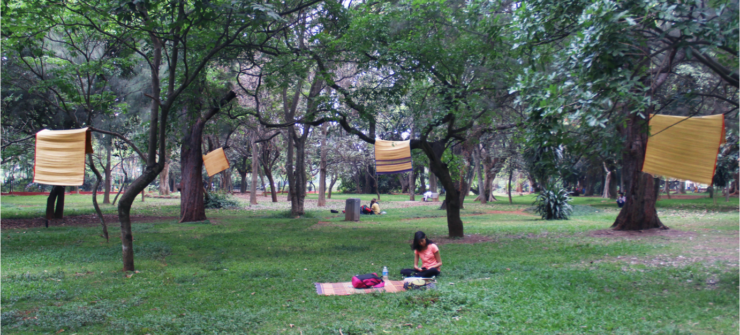[urban interfaces] Blogs
Imagining Dark Ecologies
Written by Aishwarya Kumar

In his chapter Imagination, Roy Bendor (2018) posits that imagination appears to be “essentially incomplete,” in that it is suggestive, does not predetermine the outcome of the intervention. Bendor elaborates on the various ways these “unfinished media” perform, in that they “engage, evoke, provoke, or stir their users’ imagination” (Bendor 2018, 146). The media invites the audience to add to the piece and collaboratively participate in its becoming. I am unsure for what reasons such provocations are intentionally thought within media. My conjecture here is that this kind of thinking, one that opens up the media to further intervention and “material appropriation” (Bendor 2018, 146), is what Timothy Morton (2010) in his introduction to The Ecological Thought suggests as Dark Ecology. How is imagination allowed to scaffold over media in that it embodies the qualities of Dark Ecology? What are the qualities of this modality that align with Morton’s notions of Dark Ecology I would like to imagine the outline of Dark Ecologies and its possible modalities. For this I unpack a case study by Natasha Sharma, designer and artist from India and her intervention Library of Mats (2019).
The intervention placed in Cubbon Park – one of the oldest and largest parks in the city of Bangalore – saw 70 mats placed randomly over branches of trees. Nothing much was said about these mats; no concept notes were placed, nobody stood to explain its purpose or role. The mats, although ordinary looking with a recognisably local aesthetic, were not usually seen hanging off of trees. Mats like these are pieces of furniture used indoors for floor seating. To place such an object in a park with no explanation had one sole intention: to observe what kind of invitation it sent out. To place a recognisable object seemed to indicate a “shadow from the future” for the audience’s imagination to scaffold over. Or so it seemed, since it didn’t provide an entire idea, but a glimpse of it in the familiarity to the object defamiliarized by its placement. The audience wasn’t entirely sure how to respond to this object and the contact created a certain confusion and ‘hesitation’ to a usually smoothened and familiar landscape. The audience was, in the process of encountering an alien object, made aware of the space they were inhabiting and their reaction implied a certain subjective judgement. All of these encounters, according to Morton, are the affectiveness of ecological thought: “It has to do with doubt, confusion, and scepticism. … It has to do with consciousness and awareness. It has to do with ideology and critique. … It has to do with ideas of self and the weird paradoxes of subjectivity” (Morton 2010, 2).
In its openness I also noticed that the intervention almost suggested a becoming. By leaving no instructions about the mats, the mats were opened to forces – affirmative or otherwise – by those agencies that came in contact with it – “it is always to come, somewhere in the future” (Morton 2010, 3). Sharma was not inclined to force the nature of interactions, but the gesture of placing the mat was intended to create a ripple effect, albeit the qualities and texture of the ripples weren’t known. This kind of openness also resists “previous attempts to narrow down and circumscribe the range of possible interpretations of any given artwork” (Eco as cited in Bendor 2018, 147). These kinds of works intentionally “seek to facilitate ‘heteroglossia’” (Bendor 2018, 147). Heteroglossia here implies a development from uncertainty towards uncertainty, a dictionary that is not contained within normative boundaries of languages and interpretations. It opens itself each time it encounters itself and other agencies – the mat suddenly is always the mat but more than the mat in how it gets interpreted and in the diverse interpretations – people using it as a mat, as a shelter, as a backrest, as an object to be taken home, as a public property that needs to be respected, as a public object that can be vandalised, as a visual aberration, as an object adding to the visual noise of urban landscapes, and more. “Unfinishedness, therefore, appears as a range of escalating possibilities—from the almost entirely finished to the almost entirely unfinished—with each step on the spectrum evoking a different kind of imaginative response from users” (McLuhan as cited in Bendor 2018, 148). The mat is then a scaffold to the diverse “ecological thought [that] includes negativity and irony, ugliness and horror … well served by irony, because irony insists that there are other points of view that we must acknowledge” (Morton 2018, 17). The mat then possesses the quality of the ecological thought in that it is radically open to everything – one with the kind of openness within the object, what Bendor calls “Unfinished Media,” one that performs as an ecological thought and provides a certain direction towards the kind of aesthetics that could constitute Dark Ecologies.
References
Bendor, Roy. 2018. “Imagination.” In Interactive Media for Sustainability, 129-64. London: Palgrave.
Morton, Timothy. 2010. “Introduction: Critical Thinking.” In The Ecological Thought, 1-19. Cambridge, MA: Harvard University Press. http://search.ebscohost.com.proxy.library.uu.nl/login.aspx?direct=true&db=nlebk&AN=390177&sit e=ehost-live&ebv=EB&ppid=pp_1
Sharma, Natasha. 2019. “Library of Mats: Social Intervention.” Accessed March 11, 2020. https://www.natashasharma.co/libraryofmats.
This article is part of the graduate seminar series Urban Ecologies 2020.

